Preprint
Article
MOC Composites for Constructions: Improvement of Water-resistance by Addition of Nanodopants and Polyphenol
Altmetrics
Downloads
89
Views
35
Comments
0
A peer-reviewed article of this preprint also exists.
supplementary.docx (141.65KB )
This version is not peer-reviewed
Submitted:
16 October 2023
Posted:
18 October 2023
You are already at the latest version
Alerts
Abstract
The topic of modification of magnesium oxychloride cement (MOC) via specific functional additives is very much pronounced in the research of alternative building materials. This study deals with the co-doping of MOC by 1D and 2D carbon nanomaterials in order to improve its mechanical properties while using tannic acid (TA) as a surfactant. Furthermore, the effect of TA on MOC also covers the improvement of water resistance. As a filler, three size fractions of standard quartz sand are used. The proposed types of MOC-based composites show promising results considering their mechanical, macro- and microstructural, chemical, and hygric properties. The use of 1D and 2D nanoadditives and their mixture enables the improvement of the flexural strength and most of all softening coefficient, the durability parameter characterizing the resistance of the prepared materials to water. For samples immersed in water for 24 h, the compressive strength of all modified composites tested was higher than that of the reference composite. Quantitatively, the developed co-doped composite shows mechanical parameters comparable to or even better than those of commonly used Portland cement-based materials, while maintaining high environmental efficiency. This indicates its potential use as an environmentally friendly alternative to Portland cement-based products.
Keywords:
Subject: Chemistry and Materials Science - Ceramics and Composites
1. Introduction
In the attempts to mitigate the carbon footprint originating in the construction and building industry, researchers turn to alternative composite materials, which could possibly replace the commonly used Portland cement (PC). Among such materials, magnesium oxychloride cement (MOC) and composites on its base play a major role in the past decades. The environmental advantage of MOC compared to PC is based on its ability to capture CO2 while forming carbonates [1]. It also manifests up to 75% lower impact on the resources [2]. Generally, MOC is formed in four main phases, out of which phase 5 is the most researched one, mostly due to its simple synthesis, rapid hardening, and excellent mechanical properties [3,4].
Recent development in the research of MOC mainly covers two approaches. The first one is the utilization of waste fillers and modifiers, and it is based on the ability of MOC to contain a large amount of aggregate while maintaining good mechanical performance. This approach further broadens the environmental sustainability of MOC-based materials, as it usually concerns wastes, which would otherwise need to be landfilled. Among the most used additives in this regard are various types of ash, waste wood, gypsum, sludge, and many others [5,6,7,8,9,10]. The second approach is based on the functional improvement of the properties of the composites based on MOC. For this purpose, the MOC matrix is modified using specific types of materials and additives. The most pronounced material properties in this regard are durability, water resistance, and mechanical performance. The studies concerning this approach usually result in highly functional materials based on MOC applicable in variable conditions. Davras et al. studied the effect of mixing ratios during the production of MOC-based lightweight composites using hydrogen peroxide, potassium iodide, and methylcellulose [11]. The proposed ratio of the raw materials enabled the production of ultra-lightweight MOC composite. Another type of lightweight high-performance MOC-based composite was proposed by Abd-El-Raoof et al. [12]. The base of this experiment was the modification of the MOC matrix using polymers. Yan et al. studied the influence of multiple inorganic salts on the hydration reactions occurring during MOC formation. This study has shown that such salts can promote the reaction rate, resulting in a higher amount of present MOC Phase 5 and shortened curing time [13]. The studies on the improvement of water resistance of MOC usually concern the application of functional additives, such as silica fume/nano-silica, hydroxyacetic acid, soluble phosphates, tannin, or carbon-based nanomaterials [14,15,16,17,18].
The introduction of carbon-based nanomaterials into construction composites is a highly researched topic. The main contribution of such additives is based on their high potential to improve the physical and mechanical properties of such composites, especially in hydration behavior, strength, durability, and electrical and thermal conductivity. Furthermore, specific carbon-based nanomaterials can also provide specific functional properties and smart functions. All of the enhancements can be attributed to their unique properties and microstructure [19]. The influence of carbon-based nanomaterials on the hydration reaction is based on the facilitation of the pozzolanic reaction. This phenomenon is caused by the formation of nucleation sites where the cement hydrate phases sediment and grow [20,21,22]. The improvement in mechanical properties is based on the use of carbon-based nanomaterials as nano-reinforcements. The enhancement rate is relatively high, especially considering the low proportions of the used nanomaterial. Among these properties, the compressive, tensile, flexural, and fracture strengths, and elastic moduli are generally improved [23,24]. The increase in durability is based on the refined pore structure and the reduced pore connectivity, which hinders the transport of aggressive ions and harmful agents. Furthermore, carbon-based nanomaterial-enhanced composites have been proven to have increased durability to chloride and sulfate ions, carbon dioxide molecules, and decalcification agents [25,26,27,28]. The improvement of thermal and electrical conductivity is based on the excellent thermal and electrical properties of the carbon-based nanomaterials themselves, which translate into the properties of the composite into which they are introduced [29,30,31]. The provided smart functions of the cement-based composites are mainly represented in self-sensing cement or environmental monitors for the detection of moisture or chloride content [32,33,34,35].
The enhancement of the composite material can be also further improved using a combination or hybrid of multiple types of carbon-based nanomaterials. Li et al. studied the influence of the combination of graphene oxide sheets and single-walled carbon nanotubes. This research has shown the significance of the co-effect of these two nanomaterials compared to their individual use. Furthermore, their influence on the particle size of the matrix crystals and its influence on the mechanical parameters have been assessed [36]. Lu et al. studied the dispersion of such a combination of nanoadditives showing that graphene oxide can work as a surfactant for the homogenization of carbon nanotubes in water suspension. This effect is based on the increased electrostatic repulsion. As a result, more load is transferred from the matrix to the nano-reinforcement, resulting in enhanced compressive and flexural strength were obtained [37]. The combination of multi-walled carbon nanotubes and graphene sheets has been proven useful in the enhancement of fracture toughness and microhardness of the prepared composites. These effects were assigned to a decrease in the porosity of the composite and a possible bridging effect of the nanoadditives, which resulted in the mitigation of crack propagation [38]. Yoo et al. have also shown the positive influence of combined carbon-based nanomaterials on the electrical properties of construction composites. This research has shown, how the degradation of electrical properties can be decelerated using multi-walled carbon nanotubes, graphene nanoplatelets, and nanofibers [39].
The most pronounced challenge in the introduction of carbon-based nanomaterials into construction composites is their homogenous dispersion in the cementitious matrix. It has been previously shown that these additives can show their full potential only when separated as much as possible, which is problematic due to their tendency to clump together [40,41]. This is caused by the Van der Waals forces present in their atomic structure [42,43,44,45]. The formation of agglomerates or clumps can result in weak spots in the microstructure of the composite, causing increased susceptibility to defects [46,47]. To ensure proper homogenization of the carbon-based nanomaterials both specific incorporation methods and agents are used. Among the methods, ultrasonication is one of the most applied ones [48]. As dispersing agents, mostly polycarboxylate-based surfactants, methylcellulose, or anionic superplasticizers are used. Their effect is based on steric hindrance or static charge repulsion [49,50,51]. As an environmentally friendly surfactant, tannic acid was previously studied [52]. The base of its function as a surfactant lies in its adsorption onto the carbon-based nanomaterial creating a π- π interaction between the aromatic rings of tannic acid and carbon atoms in the structure of the nanomaterial. This increases the steric repulsion between the individual carbon nanomaterial particles, which makes them easier to disperse [53,54].
This study concerns the research of MOC-based composites enhanced by the combination of various types of carbon-based nanomaterials, while simultaneously doped by tannic acid, a specific type of tannin, a type of polyphenol. The expected effect of the tannic acid is dual. First, it should work as a functional additive for the improvement of the water resistance of the MOC-based composite. Second, it is applied as a surfactant for homogenous dispersion of the applied carbon-based nanoadditives. The proposed composites should therefore manifest high values of mechanical parameters, which are further enhanced by the carbon-based nanoadditives as well as high water resistance ensured by the tannic acid. Such composites can find use in construction, especially in specifically shaped or prefabricated elements.
2. Materials and Methods
For the preparation of the MOC-based composite samples, the following chemicals were used: MgCl2∙6H2O (>99 %, Lachner s.r.o., Neratovice, Czech Republic), MgO (>98%, Penta s.r.o., Prague, Czech Republic), graphene nanoplatelets with declared specific surface of 750 m2·g-1 and particle size <2 µm (2D Sigma Aldrich, St. Louis, USA), multi-walled carbon nanotubes TNIM8 with declared purity >95 %, specific surface area >60 m2·g-1, and length <10 µm (1D, TimesNano, Chengdu, China), tannic acid (TA, Carl Roth GmbH + Co. KG, Karlsruhe, Germany), and quartz sand with three size fractions of 0-0.5, 0.5-1.0, and 1.0-2.0 mm, named PG1, PG2, and PG3, respectively (Filtrační písky, s.r.o., Chlum, Czech Republic). The designation of the samples was set as follows: REF for reference MOC sample with quartz sand filler, TA for MOC sample with quartz sand filler and tannic acid, 1D-TA for MOC sample with quartz sand filler, multi-walled carbon nanotubes, and tannic acid, 2D-TA for MOC sample with quartz sand filler, graphene nanoplatelets, and tannic acid, and 1D-2D-TA for MOC sample with quartz sand filler, multi-walled carbon nanotubes, graphene nanoplatelets, and tannic acid. Furthermore, a sample named PASTE consisting of only MOC with no filler was prepared. The fresh mixture properties of the specific samples are summarized in Table 1. The synthesis of the samples consisted of the preparation of an aqueous solution of MgCl2∙6H2O, in which the functional additives such as tannic acid, graphene nanoplatelets, and/or multi-walled carbon nanotubes were dispersed using a mechanical rotor-stator homogenizer Ultra-Turrax T-18 (IKA, Königswinter, Germany) for 5 minutes at a speed of 10,000 rpm. For the samples REF and PASTE, this step was not done. After that, the MgO powder, the homogenized MgCl2 solution/suspension of additives in MgCl2 solution, and the quartz sand filler were mixed together in a planetary type of mortar mixer. First, a low-speed regime (140 rpm) was used for 1 minute and then, a high-speed regime (285 rpm) was used for 1 minute. After that, the mixer bowl and paddle were scraped, and the mixing continued for 3 minutes at the high-speed regime. The prepared mixtures were then poured into prismatic molds with the dimensions of 40 × 40 × 160 mm3, where they were left for 24 h. After that, they were demolded and cured for 27 days at T = (23±2)°C, and RH = (50±5)%.
The samples cured for 28 days were used for multiple types of analyses. Their phase and chemical composition, microstructure and morphology, micro- and macrostructural properties, mechanical parameters, and hygric properties were studied. More experimental details can be found in our previous publications aimed at the research of MOC-based materials [55,56].
3. Results
In this study, five types of MOC-based composites were prepared. The influence of adding 1D and 2D carbon-based nanomaterials individually and in combination and tannic acid was studied. A photograph of the prepared samples is shown in Figure 1.
Before the composite samples were studied, the phase composition of the PASTE sample prepared without any filler or additive was determined via XRD. The diffraction pattern (see Figure 2) shows the presence of two phases. The majority of the sample consists of MOC Phase 5 (ICDD 04-014-8836) [57] with the main reflection at 2θ=11.896°. The minor crystalline phase present in the pattern is chlorartinite (ICDD 04-015-1149) with the main reflection at 2θ=7.576°, which is a resulting phase of CO2 capture reaction occurring on the surface of MOC [58].
The XRD analysis of the prepared MOC-based composites has revealed the presence of two major crystalline phases in all of the samples. First, silicon oxide in the form of quartz (ICDD 04-016-2085) with the main reflection at 2θ=26.649° was present [59]. This phase can be assigned to the presence of quartz sand used as a filler in all of the composite samples. Second, MOC Phase 5 presence was confirmed similarly to the paste sample. For the samples with tannic acid and carbon-based nanomaterials, the additives were not determined in the diffraction patterns mainly due to their very low content. The XRD patterns of all of the prepared MOC-based composite samples are shown in Figure 3.
The chemical composition of the prepared MOC-based composites was studied using EDS. This method ensured both the elemental maps (see Figure 4) as well as the percentual content of each present element (see Table 2). In all of the samples carbon, oxygen, magnesium, silicon, and chlorine were present. The quantity of each element corresponded well with the intended composition of the composite.
Next, SEM was used to study the microstructure of the prepared samples. The typical microstructure of MOC Phase 5 was very well visible on the micrographs of the PASTE sample (see Figure 5), which did not contain any filler. The MOC Phase 5 needles with a length between 1 and 5 μm and a width of ~0.5 μm are very well visible at the highest magnification.
The micrographs of the microstructure of the prepared MOC-based composites are shown in Figure 6. Especially at a higher magnification, it can be seen that the presence of MOC Phase 5 in the form of needle-shaped crystals was proved. The micrographs also show, how the use of tannic acid and carbon-based nanomaterials influences the shape of the MOC needles. For all of the samples containing tannic acid, thinning of the needles is apparent. Furthermore, the sample containing both types of carbon-based nanomaterials and tannic acid shows slight bending or even curling of the MOC needles.
The macro- and microstructural parameters of the tested composites are introduced in Table 3. The data were obtained for samples cured for 28 days and represent the mean value from the measurement of 5 samples. The changes in bulk density, specific density, and porosity were minimal, and, taking into account the expanded combined uncertainty of the used test methods, they can be considered insignificant or even negligible from a practical point of view. The minimal variation of the measured fundamental structural parameters shows evidence of the positive effect of tannic acid used as a surfactant in avoiding agglomeration of nanoadditive particles and thus their homogeneous distribution in the MOC matrix. Moreover, TA itself did not negatively affect the formation of the MOC structure. The assessment of the microstructural parameters by mercury intrusion porosimetry (MIP) indicated that the porous structure was refined by the co-doping of the composite by the combination of 1D and 2D nanoparticles, which was also noticed based on the obtained macrostructural parameters. This was also observed for the composites 1D-TA and 2D-TA. The determined average pore size is a characteristic of medium capillaries, which affect mechanical strength and water permeability. The cumulative pore size distribution is shown in Figure 7. The shape of the pore size curves well corresponds with the calculated microstructural parameters. Quantitatively, the measured porosity values are low, as demonstrated by both test techniques, i.e. the combination of helium pycnometry with the gravimetric determination of bulk density and MIP. In general, as capillary porosity affects mechanical strength and stiffness, and reduces water ingress, the results obtained for nano-modified composites with TA can be considered promising.
The mechanical parameters of the investigated composites are summarized in Figure 8. The composites exhibited high mechanical strength and stiffness. The flexural/compressive strength ratio was about 30%, which is much higher than that reported for PC concrete, whose flexural strength makes up approximately 10-20% of its compressive strength [60]. In general, the addition of tannic acid as well as nanoadditives slightly decreased the compressive strengths and slightly increased flexural strengths of prepared composites. Dynamic Young’s modulus was almost identical for all samples.
Water absorption values are presented in Figure 9. A slight decrease in water absorption was obtained for all enhanced composites; however, the major positive influence of the dopants was proved after water immersion for 24 hours, while low water resistance is the major disadvantage of MOC-based materials for outdoor applications. As can be seen from Figure 8, after the water immersion the highest compressive strength was obtained for co-doped sample 1D-2D-TA reaching 56.9 MPa, which is much higher than the 43.7 MPa obtained for the reference sample. The softening coefficient was 51.4% for REF, 77.3% for TA, 69.8% for 1D-TA, 68.1% for 2D-TA, and 73.8% for 1D-2D-TA confirming the significant influence of tannic acid addition on compressive strengths of all composites. The increase in the softening coefficient is very promising for the practical use of the prepared materials, demonstrating their enhanced resistance to water. The improved durability is a result of the solidified structure of the composites, the effect of chelation between TA and Mg2+ ions, and their reinforcement against crack propagation induced by chemical changes of the precipitated MOC phase 5. Since TA has a high molecular weight and is rich in phenolic hydroxyl groups, it forms a chelate with Mg2+ that forms a gel-like shell on the surface of precipitated products of MOC hydration.[61] This shell prevents contact of MOC phase 5 needles with water, thus improving water resistance. The effective reinforcement of the MOC matrix is given by the fact that the used nanoadditives can bridge the pores between sand particles and MOC phase 5 crystals. Since the pores have an average pore size of about 0.05 μm, both the graphene particles and the multi-walled carbon nanotubes allow the reinforcement of these weak points in the composite microstructure. Moreover, in the case of water damage, they can partially withstand the generated tensile stress, thus at least partially eliminate the failure rate and loss of integrity.
4. Conclusions
Tannic acid was used in MOC-based composites in combination with 1D and 2D carbon-based nanoadditives to improve the technical parameters and durability of composites made of MOC and quartz sand with a major focus on water resistance. Both used nanomaterials, graphene nanoplatelets, and multi-walled carbon nanotubes and their combination, positively influenced the water resistance of the hardened materials when incorporated into composite mixtures. The application of TA enabled the avoidance of the agglomeration of nanoparticles and thus their homogeneous distribution in the MOC-sand matrix, which is the crucial and problematic step in the introduction of nanoadditives in construction materials. Since MOC is generally considered to be more environmentally friendly due to its ability to sequester CO2 from the environment of the application, the developed composites effectively modified by nanoadditives can be a potential alternative to Portland cement-based products that dominate the current construction market. In the prospective application of the researched composites, it is necessary to consider especially their excellent mechanical strength, high compressive/flexural strength ratio, and good resistance to excessive moisture.
Supplementary Materials
The following supporting information can be downloaded at the website of this paper posted on Preprints.org. Experimental details.
Author Contributions
Conceptualization, A.-M.L., O.J. and Z.P..; methodology, O.J., D.S., M.P., Z.P; formal analysis, A.-M.L., O.J., Z.P., M.P.; investigation, A.-M.L., A.J., D.S., M.Z., A.P., M.P.; data curation, O.J:, D.S., M.P., Z.P; writing—original draft preparation, A.-M.L., O.J., M.P., Z.P; writing—review and editing, A.-M.L., O.J., M.P., Z.P; supervision, O.J., D.S., M.P., Z.P; project administration, O.J, M.P.; funding acquisition, O.J., Z.P. All authors have read and agreed to the published version of the manuscript.
Funding
This research was funded by the Czech Science Foundation, project No 23-05194M. This research has been also partially supported by the Grant Agency of the Czech Technical University in Prague, grant No SGS23/149/OHK1/3T/11.
Institutional Review Board Statement
Not applicable.
Data Availability Statement
The data presented in this study are available on request from the corresponding author.
Conflicts of Interest
The authors declare no conflict of interest.
References
- Meng, D.; Unluer, C.; Yang, E.-H.; Qian, S. Recent advances in magnesium-based materials: CO2 sequestration and utilization, mechanical properties and environmental impact. Cem. Concr. Compos. 2023, 138. [Google Scholar] [CrossRef]
- Kastiukas, G.; Ruan, S.; Unluer, C.; Liang, S.; Zhou, X. Environmental Assessment of Magnesium Oxychloride Cement Samples: A Case Study in Europe. Sustainability 2019, 11, 6957. [Google Scholar] [CrossRef]
- Faltysová, I.; Lauermannová, A.-M.; Lojka, M.; Pavlík, Z.; Pavlíková, M.; Keppert, M. Study of formation of magnesium oxychloride phase MOC-518 by isothermal calorimetry. AIP Conf. Proc. 2022, 2488, 020003. [Google Scholar]
- Dehua, D.; Chuanmei, Z. ; The formation mechanism of the hydrate phases in magnesium oxychloride cement11This paper was originally submitted to Advanced Cement Based Materials. It was received at the Editorial Office of Cement and Concrete Research on 20 August 1998 and accepted in final form on 16 December 1998. Cem. Concr. Res. 1999, 29, 1365–1371. [Google Scholar]
- Maier, A.; Manea, D.L. Perspective of Using Magnesium Oxychloride Cement (MOC) and Wood as a Composite Building Material: A Bibliometric Literature Review. Materials 2022, 15, 1772. [Google Scholar] [CrossRef]
- Nie, Y.; Lu, J.; Liu, Z.; Meng, D.; He, Z.; Shi, J. Mechanical, water resistance and environmental benefits of magnesium oxychloride cement incorporating rice husk ash. Sci. Total. Environ. 2022, 849, 157871. [Google Scholar] [CrossRef] [PubMed]
- Ma, C.; Chen, G.; Cao, L.; Zhou, H.; Ren, W. Effects and mechanisms of waste gypsum influencing the mechanical properties and durability of magnesium oxychloride cement. J. Clean. Prod. 2022, 339, 130679. [Google Scholar] [CrossRef]
- Wang, D.; Chen, Z.; Gao, X. Sustainable Improvement of Magnesium Oxychloride Cement Solidified Waste Sludge with Fly-Ash Inclusion. J. Mater. Civ. Eng. 2022, 34, 04022317. [Google Scholar] [CrossRef]
- Cao, F.; Qiao, H.; Shu, X.; Cui, L.; Li, S.; Zhang, T. Potential application of highland barley straw ash as a new active admixture in magnesium oxychloride cement. J. Build. Eng. 2022, 59. [Google Scholar] [CrossRef]
- He, Z.; Han, X.; Zhang, Y.; Zhang, Z.; Shi, J.; Gencel, O. Development of a new magnesium oxychloride cement board by recycling of waste wood, rice husk ash and flue gas desulfurization gypsum. J. Build. Eng. 2022, 61. [Google Scholar] [CrossRef]
- Davraz, M.; Koru, M.; Akdağ, A.E. The Effect of Mixing Ratios on Physical, Mechanical, and Thermal Properties in Lightweight Composite with Magnesium Oxychloride Cement. Int. J. Thermophys. 2022, 44, 1–18. [Google Scholar] [CrossRef]
- Abd-El-Raoof, F.; Hegazy, A.; Rashwan, M.; Mohamed, W.; Tawfik, A. Dual-functional polymer-modified magnesium oxychloride cement pastes: Physico-mechanical, phase, and microstructure characterizations. J. Build. Eng. 2022, 57. [Google Scholar] [CrossRef]
- Yan, Z.; Yang, P.; Huang, J.; Jia, Q.; Wen, J.; Dong, J.; Zheng, W.; Chang, C.; Wang, H.; Chen, R. Promoting effect and mechanism of several inorganic salts on hydration reaction of magnesium oxychloride cement at low temperature. Constr. Build. Mater. 2021, 317, 126171. [Google Scholar] [CrossRef]
- El-Feky, M.; Mohsen, A.; El-Tair, A.M.; Kohail, M. Microstructural investigation for micro - nano-silica engineered magnesium oxychloride cement. Constr. Build. Mater. 2022, 342. [Google Scholar] [CrossRef]
- Luo, X.; Fan, W.; Li, C.; Wang, Y.; Yang, H.; Liu, X.; Yang, S. Effect of hydroxyacetic acid on the water resistance of magnesium oxychloride cement. Constr. Build. Mater. 2020, 246, 118428. [Google Scholar] [CrossRef]
- Deng, D. The mechanism for soluble phosphates to improve the water resistance of magnesium oxychloride cement. Cem. Concr. Res. 2003, 33, 1311–1317. [Google Scholar] [CrossRef]
- Sun, X.; Ye, Q.; Zhou, W.; Han, Y.; Gong, S.; Zhou, W.; Shi, S.Q.; Li, J.; Fang, Z. Tannin-modified magnesium oxychloride cement with high-strength and reinforced water-resistance. J. Clean. Prod. 2022, 374. [Google Scholar] [CrossRef]
- Lauermannová, A.-M.; Lojka, M.; Sklenka, J.; Záleská, M.; Pavlíková, M.; Pivák, A.; Pavlík, Z.; Jankovský, O. Magnesium oxychloride-graphene composites: Towards high strength and water resistant materials for construction industry. FlatChem 2021, 29, 100284. [Google Scholar] [CrossRef]
- Du, M.; Jing, H.; Gao, Y.; Su, H.; Fang, H. Carbon nanomaterials enhanced cement-based composites: advances and challenges. Nanotechnol. Rev. 2020, 9, 115–135. [Google Scholar] [CrossRef]
- Chen, S.J.; Wang, W.; Sagoe-Crentsil, K.; Collins, F.; Zhao, X.L.; Majumder, M.; Duan, W.H. Distribution of carbon nanotubes in fresh ordinary Portland cement pastes: understanding from a two-phase perspective. RSC Adv. 2016, 6, 5745–5753. [Google Scholar] [CrossRef]
- Makar, J.M.; Chan, G.W. Growth of Cement Hydration Products on Single-Walled Carbon Nanotubes. J. Am. Ceram. Soc. 2009, 92, 1303–1310. [Google Scholar] [CrossRef]
- Wang, B.; Jiang, R.; Wu, Z. Investigation of the Mechanical Properties and Microstructure of Graphene Nanoplatelet-Cement Composite. Nanomaterials 2016, 6, 200. [Google Scholar] [CrossRef] [PubMed]
- Shamsaei, E.; de Souza, F.B.; Yao, X.; Benhelal, E.; Akbari, A.; Duan, W. Graphene-based nanosheets for stronger and more durable concrete: A review. Constr. Build. Mater. 2018, 183, 642–660. [Google Scholar] [CrossRef]
- Xu, Y.; Zeng, J.; Chen, W.; Jin, R.; Li, B.; Pan, Z. A holistic review of cement composites reinforced with graphene oxide. Constr. Build. Mater. 2018, 171, 291–302. [Google Scholar] [CrossRef]
- Sanchez, F.; Zhang, L.; Ince, C. Multi-scale Performance and Durability of Carbon Nanofiber/Cement Composites. In Nanotechnology in Construction.; Bittnar, Z., Bartos, P.J.M., Němeček, J., Šmilauer, V., Zeman, J., Eds.; Springer: Berlin, Heidelberg, 2009; Volume 3, pp. 345–350. [Google Scholar]
- Lu, L.; Ouyang, D.; Xu, W. Mechanical Properties and Durability of Ultra High Strength Concrete Incorporating Multi-Walled Carbon Nanotubes. Materials 2016, 9, 419. [Google Scholar] [CrossRef]
- Wang, B.-M.; Liu, S.; Han, Y.; Leng, P. Preparation and Durability of Cement-Based Composites Doped with Multi-Walled Carbon Nanotubes. Nanosci. Nanotechnol. Lett. 2015, 7, 411–416. [Google Scholar] [CrossRef]
- del Carmen Camacho, M.; Galao, O.; Baeza, F.J.; Zornoza, E.; Garcés, P. Mechanical Properties and Durability of CNT Cement Composites. Materials 2014, 7, 1640–1651. [Google Scholar] [CrossRef]
- Copolla, L.; Buosa, A.; Corazza, F. Electrical Properties of Carbon Nanotubes Cement Composites for Monitoring Stress Conditions in Concrete Structures. Appl. Mech. Mater. 2011, 82, 118. [Google Scholar] [CrossRef]
- Bai, S.; Jiang, L.; Xu, N.; Jin, M.; Jiang, S. Enhancement of mechanical and electrical properties of graphene/cement composite due to improved dispersion of graphene by addition of silica fume. Constr. Build. Mater. 2018, 164, 433–441. [Google Scholar] [CrossRef]
- Le, J.-L.; Du, H.; Pang, S.D. Use of 2D Graphene Nanoplatelets (GNP) in cement composites for structural health evaluation. Compos. Part B: Eng. 2014, 67, 555–563. [Google Scholar] [CrossRef]
- Jang, S.-H.; Hochstein, D.P.; Kawashima, S.; Yin, H. Experiments and micromechanical modeling of electrical conductivity of carbon nanotube/cement composites with moisture. Cem. Concr. Compos. 2017, 77, 49–59. [Google Scholar] [CrossRef]
- Sheikh, T.M.; Anwar, M.P.; Muthoosamy, K.; Jaganathan, J.; Chan, A.; Mohamed, A.A. The mechanics of carbon-based nanomaterials as cement reinforcement — A critical review. Constr. Build. Mater. 2021, 303, 124441. [Google Scholar] [CrossRef]
- Kim, H.-K. Chloride penetration monitoring in reinforced concrete structure using carbon nanotube/cement composite. Constr. Build. Mater. 2015, 96, 29–36. [Google Scholar] [CrossRef]
- Pang, S.D.; Gao, H.J.; Xu, C.; Quek, S.T.; Du, H. Strain and damage self-sensing cement composites with conductive graphene nanoplatelet. Proc. SPIE 2014, 9061, 906126. [Google Scholar]
- Li, X.; Wei, W.; Qin, H.; Hu, Y.H. Co-effects of graphene oxide sheets and single wall carbon nanotubes on mechanical properties of cement. J. Phys. Chem. Solids 2015, 85, 39–43. [Google Scholar] [CrossRef]
- Lu, Z.; Hou, D.; Meng, L.; Sun, G.; Lu, C.; Li, Z. Mechanism of cement paste reinforced by graphene oxide/carbon nanotubes composites with enhanced mechanical properties. RSC Adv. 2015, 5, 100598–100605. [Google Scholar] [CrossRef]
- Liu, J.; Fu, J.; Ni, T.; Yang, Y. Fracture toughness improvement of multi-wall carbon nanotubes/graphene sheets reinforced cement paste. Constr. Build. Mater. 2018, 200, 530–538. [Google Scholar] [CrossRef]
- Yoo, D.-Y.; You, I.; Lee, S.-J. Electrical Properties of Cement-Based Composites with Carbon Nanotubes, Graphene, and Graphite Nanofibers. Sensors 2017, 17, 1064. [Google Scholar] [CrossRef] [PubMed]
- Chen, S.J.; Collins, F.G.; Macleod, A.J.N.; Pan, Z.; Duan, W.H.; Wang, C.M. Carbon nanotube–cement composites: A retrospect. The IES Journal Part A: Civil & Structural Engineering 2011, 4, 254–265. [Google Scholar]
- Collins, F.; Lambert, J.; Duan, W.H. The influences of admixtures on the dispersion, workability, and strength of carbon nanotube–OPC paste mixtures. Cem. Concr. Compos. 2012, 34, 201–207. [Google Scholar] [CrossRef]
- De Jong, K.P.; Geus, J.W. Carbon Nanofibers: Catalytic Synthesis and Applications. Sci. Eng. 2000, 42, 481–510. [Google Scholar] [CrossRef]
- Popov, V.N. Carbon nanotubes: properties and application. Mater. Sci. Eng. R Rep. 2004, 43, 61–102. [Google Scholar] [CrossRef]
- Zhu, Y.; Murali, S.; Cai, W.; Li, X.; Suk, J.W.; Potts, J.R.; Ruoff, R.S. Graphene and Graphene Oxide: Synthesis, Properties, and Applications. Adv. Mater. 2010, 22, 5226–5226. [Google Scholar] [CrossRef]
- Gómez-Navarro, C.; Meyer, J.C.; Sundaram, R.S.; Chuvilin, A.; Kurasch, S.; Burghard, M.; Kern, K.; Kaiser, U. Atomic Structure of Reduced Graphene Oxide. Nano Lett. 2010, 10, 1144–1148. [Google Scholar] [CrossRef] [PubMed]
- Chuah, S.; Li, W.; Chen, S.J.; Sanjayan, J.G.; Duan, W.H. Investigation on dispersion of graphene oxide in cement composite using different surfactant treatments. Constr. Build. Mater. 2018, 161, 519–527. [Google Scholar] [CrossRef]
- Sobolkina, A.; Mechtcherine, V.; Khavrus, V.; Maier, D.; Mende, M.; Ritschel, M.; Leonhardt, A. Dispersion of carbon nanotubes and its influence on the mechanical properties of the cement matrix. Cem. Concr. Compos. 2012, 34, 1104–1113. [Google Scholar] [CrossRef]
- Higashitani, K.; Yoshida, K.; Tanise, N.; Murata, H. Dispersion of coagulated colloids by ultrasonication. Colloids Surfaces A: Physicochem. Eng. Asp. 1993, 81, 167–175. [Google Scholar] [CrossRef]
- Borode, A.O.; Ahmed, N.A.; Olubambi, P.A. Surfactant-aided dispersion of carbon nanomaterials in aqueous solution. Phys. Fluids 2019, 31. [Google Scholar] [CrossRef]
- Borovskaya, A.; Idiatullin, B.Z.; Zueva, O.S. Carbon nanotubes in the surfactants dispersion: formation of the microenvironment. J. Physics: Conf. Ser. 2016, 690, 012030. [Google Scholar] [CrossRef]
- Gao, Y.; Jing, H.; Du, M.; Chen, W. Dispersion of Multi-Walled Carbon Nanotubes Stabilized by Humic Acid in Sustainable Cement Composites. Nanomaterials 2018, 8, 858. [Google Scholar] [CrossRef]
- Negm, N.A.; El Farargy, A.F.M.; Mohammed, D.E.; Mohamad, H.N. Environmentally Friendly Nonionic Surfactants Derived from Tannic Acid: Synthesis, Characterization and Surface Activity. J. Surfactants Deterg. 2012, 15, 433–443. [Google Scholar] [CrossRef]
- Lin, D.; Xing, B. Tannic Acid Adsorption and Its Role for Stabilizing Carbon Nanotube Suspensions. Environ. Sci. Technol. 2008, 42, 5917–5923. [Google Scholar] [CrossRef]
- Wang, T.; Jing, L.-C.; Zhu, Q.; Ethiraj, A.S.; Fan, X.; Liu, H.; Tian, Y.; Zhu, Z.; Meng, Z.; Geng, H.-Z. Tannic acid modified graphene/CNT three-dimensional conductive network for preparing high-performance transparent flexible heaters. J. Colloid Interface Sci. 2020, 577, 300–310. [Google Scholar] [CrossRef]
- Pavlíková, M.; Kapicová, A.; Záleská, M.; Pivák, A.; Jankovský, O.; Lauermannová, A.-M.; Lojka, M.; Faltysová, I.; Slámová, J.; Pavlík, Z. Ultra-high strength multicomponent composites based on reactive magnesia: Tailoring of material properties by addition of 1D and 2D carbon nanoadditives. J. Build. Eng. 2022, 50. [Google Scholar] [CrossRef]
- Jankovský, O.; Lojka, M.; Lauermannová, A.-M.; Antončík, F.; Pavlíková, M.; Záleská, M.; Pavlík, Z.; Pivák, A.; Sedmidubský, D. Towards novel building materials: High-strength nanocomposites based on graphene, graphite oxide and magnesium oxychloride. Appl. Mater. Today 2020, 20, 100766. [Google Scholar] [CrossRef]
- Sugimoto, K.; Dinnebier, R.E.; Hanson, J.C. Structures of three dehydration products of bischofite from in situ synchrotron powder diffraction data (MgCl2. nH2O; n = 1, 2, 4). Acta Cryst. 2007, 63, 235–242. [Google Scholar] [CrossRef]
- Zayakina, N.; Ugapeva, S.; Oleinikov, O. Rare hydrated magnesium carbonate minerals of the kimberlite pipe Obnazhennaya, The Yakutian Kimberlite Province. IOP Conf. Series: Earth Environ. Sci. 2020, 609, 012007. [Google Scholar] [CrossRef]
- Henry, P.F.; Weller, M.T.; Wilson, C.C. Hydrogenous materials using powder neutron diffraction: full structural determination of adsorbed water molecules in a zeolite. Chem. Commun. 2008, 1557–1559. [Google Scholar] [CrossRef] [PubMed]
- Lee, D.T.C.; Lee, T.S.; Hasan, A.; Khan, A.; Mannan, A.; Hipolito, C.; Sutan, N.M.; Othman, A.-K.H.; Kabit, M.; Wahab, N.A. The effect of aggregate condition during mixing on the mechanical properties of oil palm shell (OPS) concrete. In MATEC Web of Conferences; EDP Sciences: 2017; Volume 87. [CrossRef]
- Wen, J.; Yu, H.; Wu, C.; Li, Y.; Dong, J.; Zheng, L. Hydration kinetic and influencing parameters in hydration process of magnesium oxychloride cement. Journal of the Chinese Ceramic Society 2013, 41, 588–596. [Google Scholar]
Figure 1.
This Photograph of prepared MOC-based composite samples (from left REF, TA, 1D-TA, 2D-TA, 1D-2D-TA).
Figure 1.
This Photograph of prepared MOC-based composite samples (from left REF, TA, 1D-TA, 2D-TA, 1D-2D-TA).
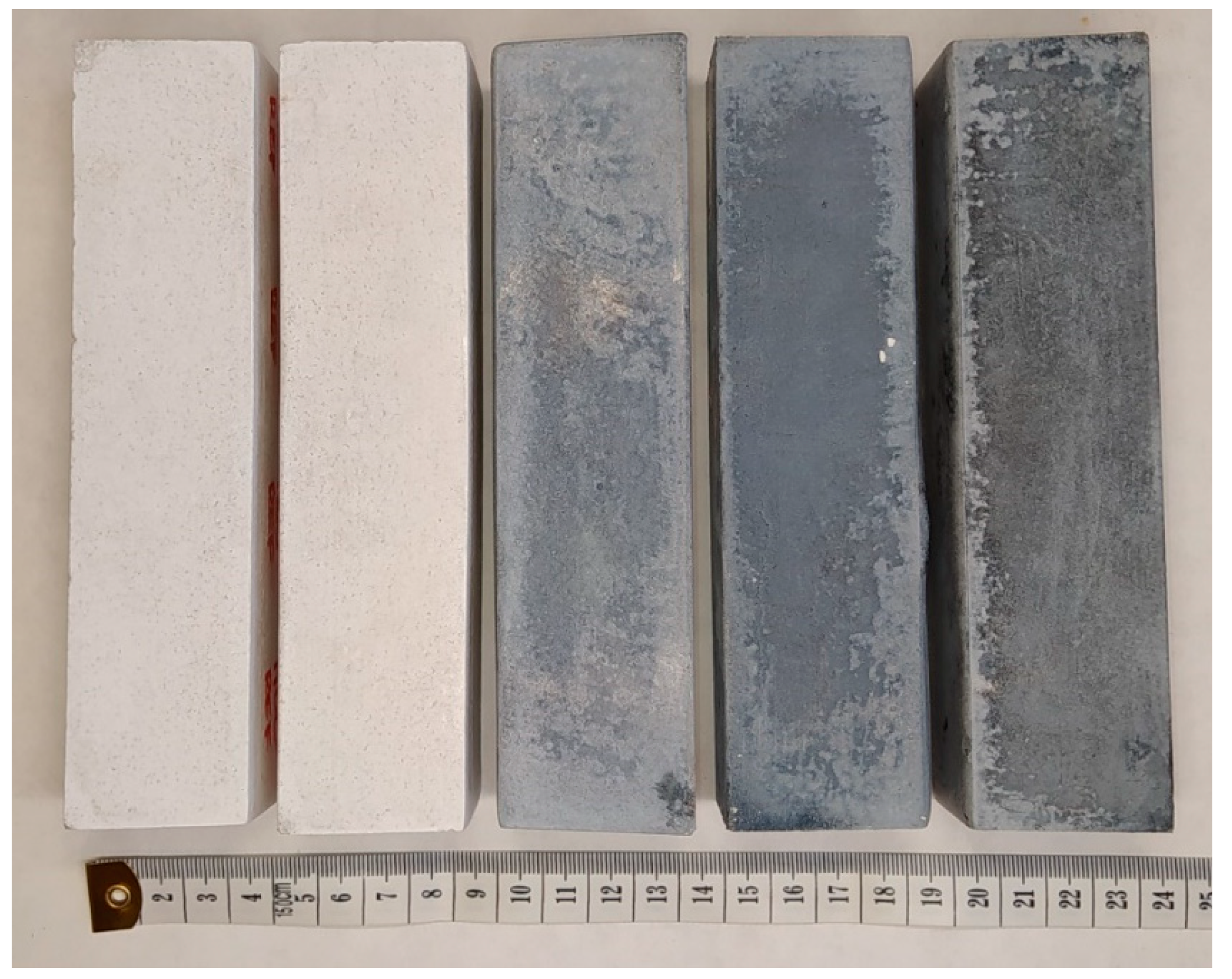
Figure 2.
XRD pattern of the prepared MOC paste.
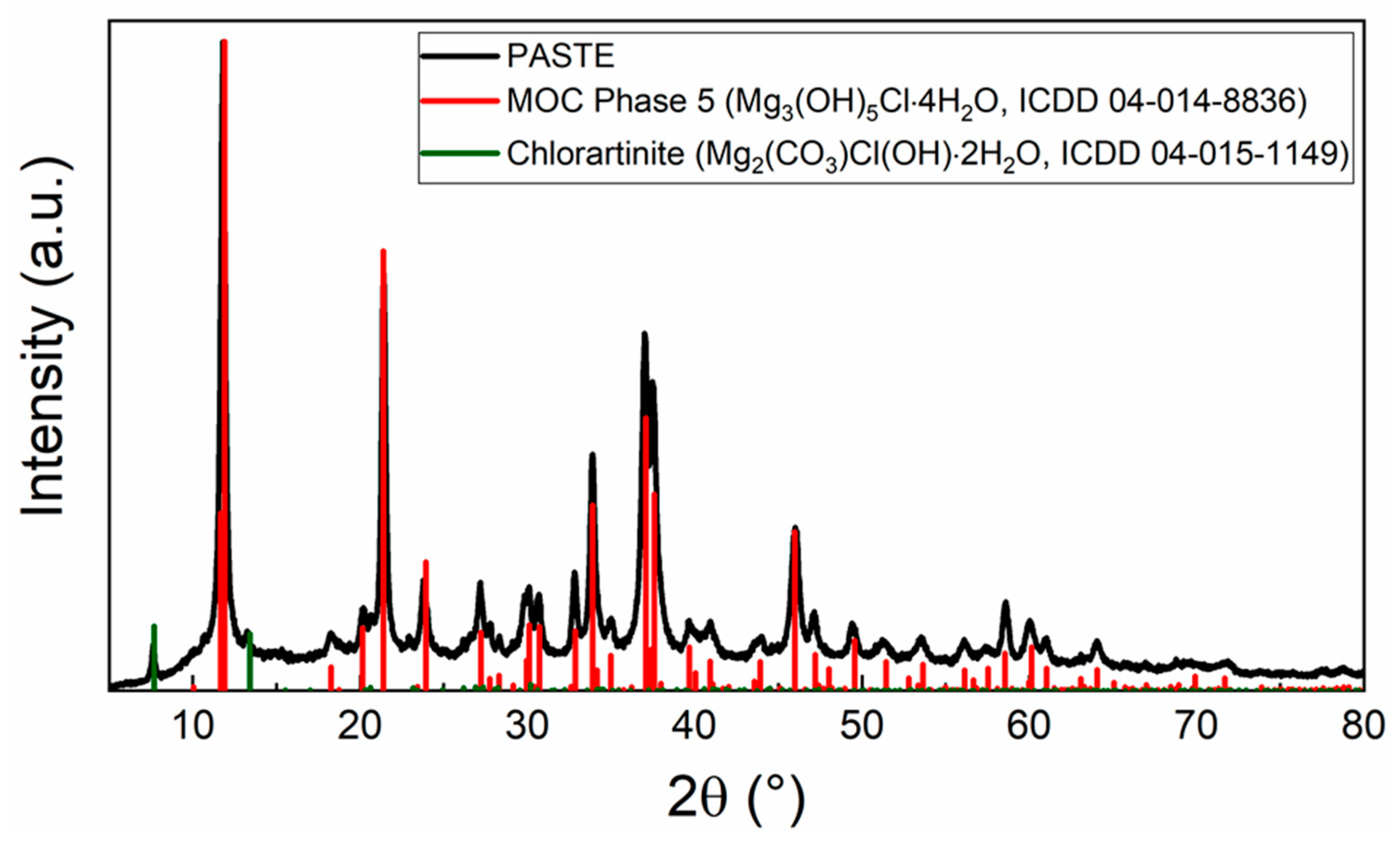
Figure 3.
XRD patterns of prepared MOC-based composite samples.
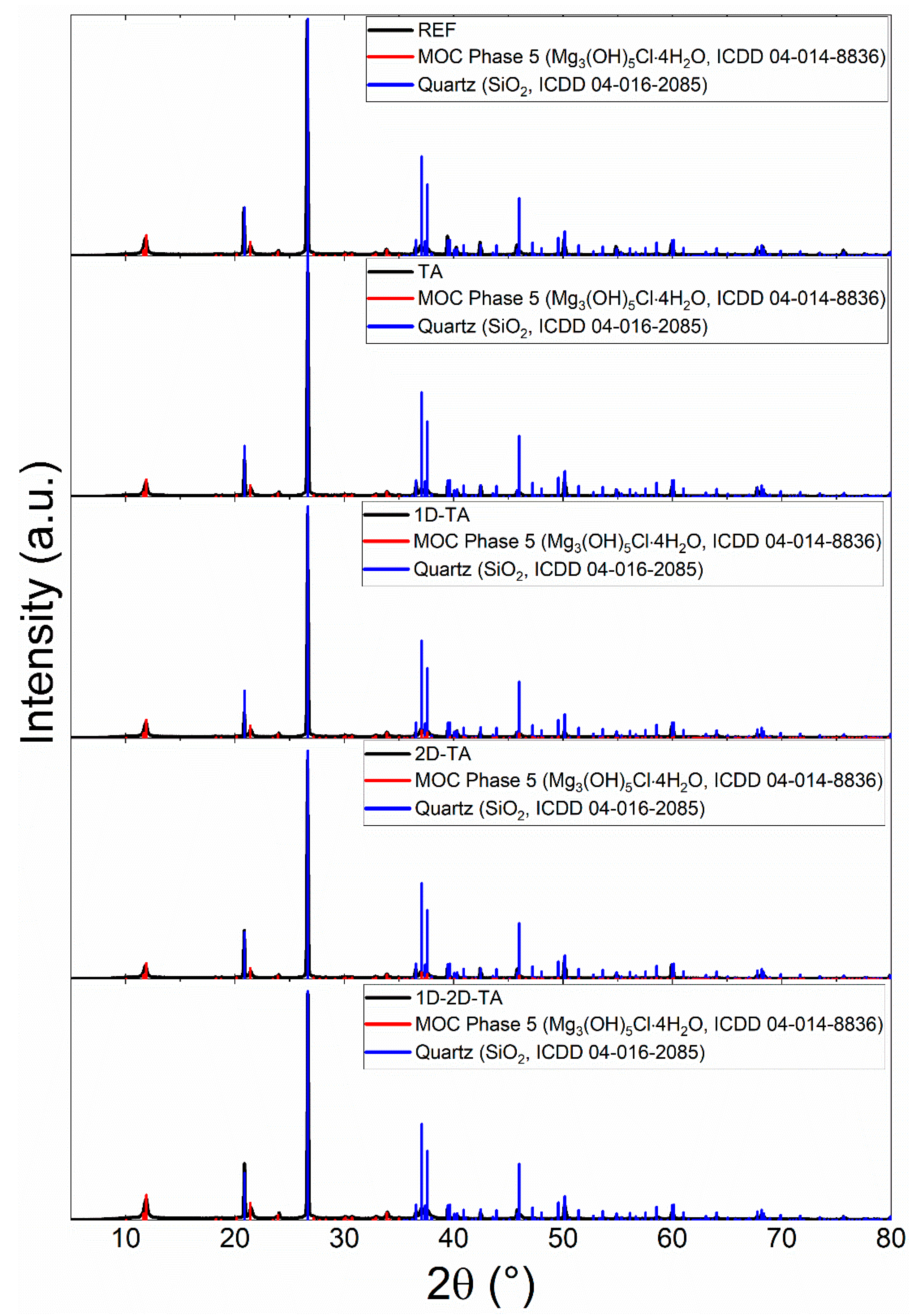
Figure 4.
Elemental maps of prepared MOC-based composites obtained from EDS.
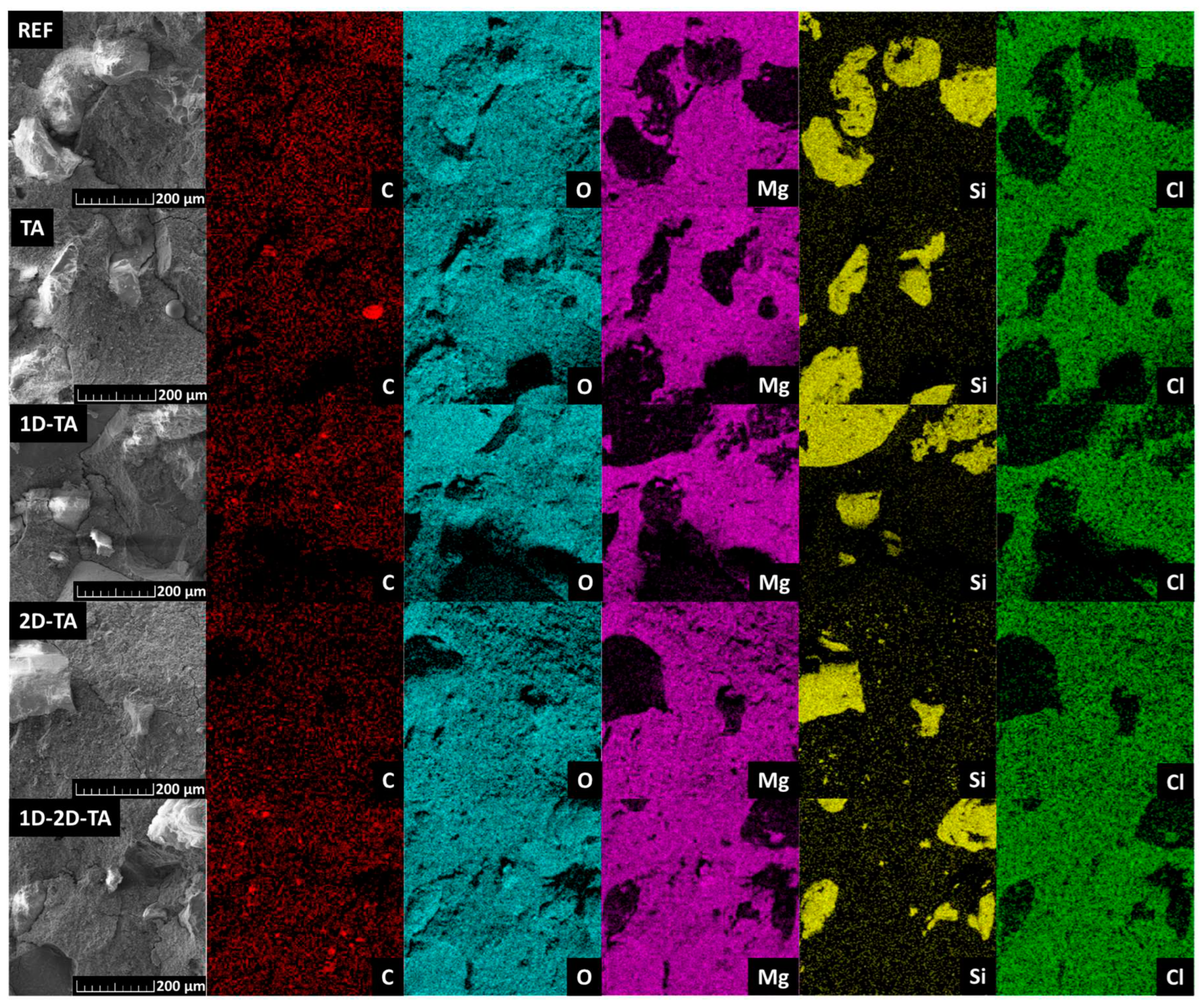
Figure 5.
SEM micrographs of typical MOC Phase 5 microstructure measured on paste.
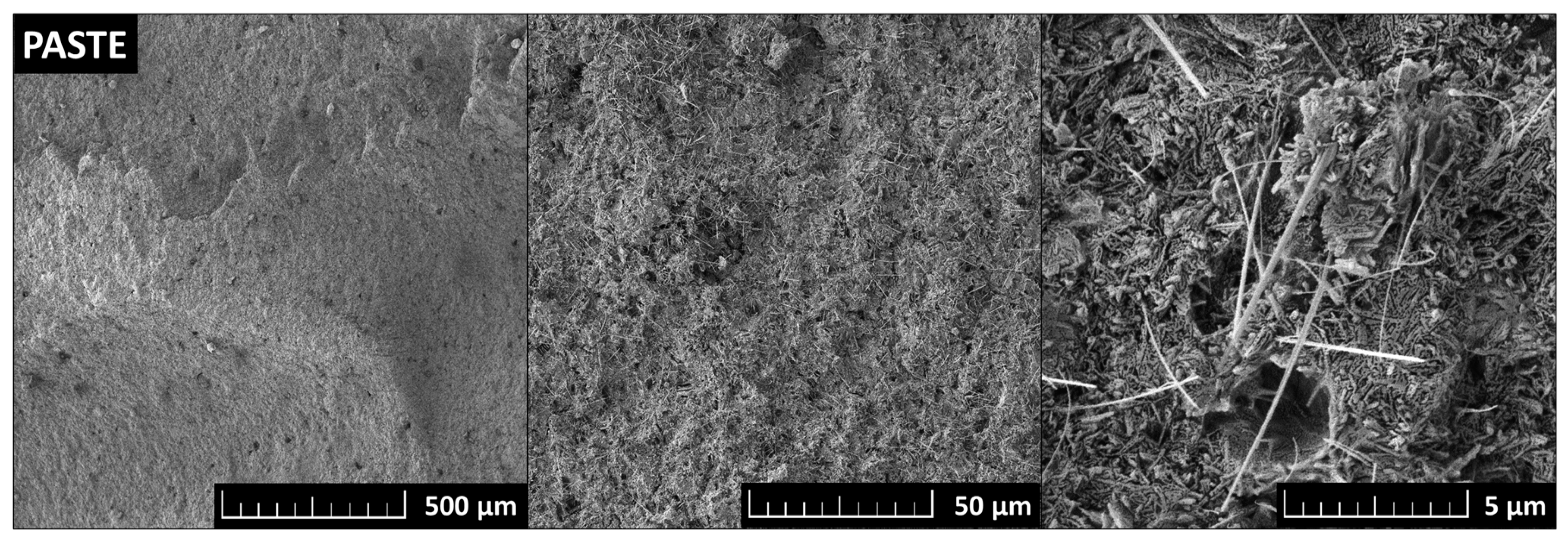
Figure 6.
SEM micrographs of prepared MOC-based composites.
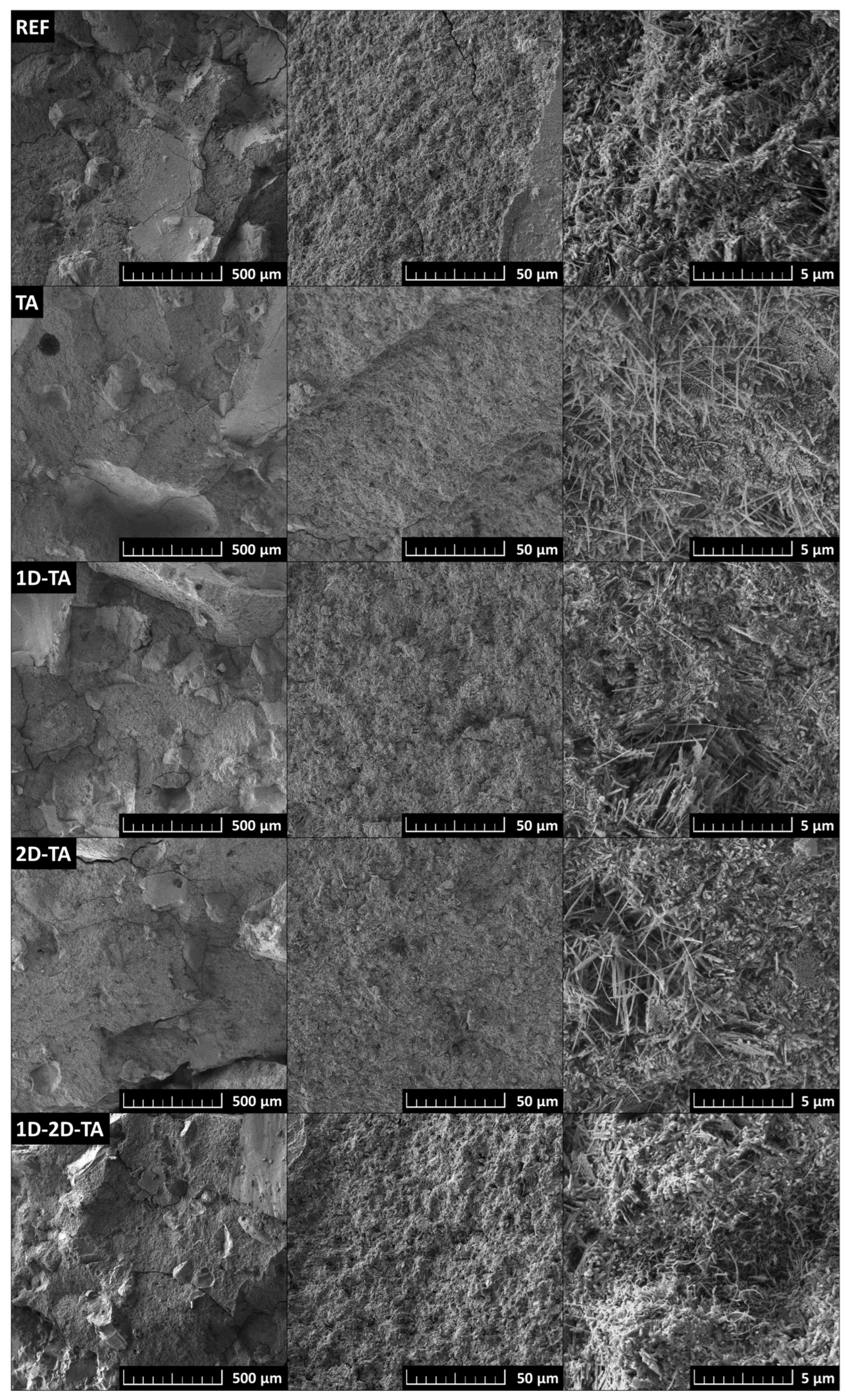
Figure 7.
Cumulative pore size distribution.
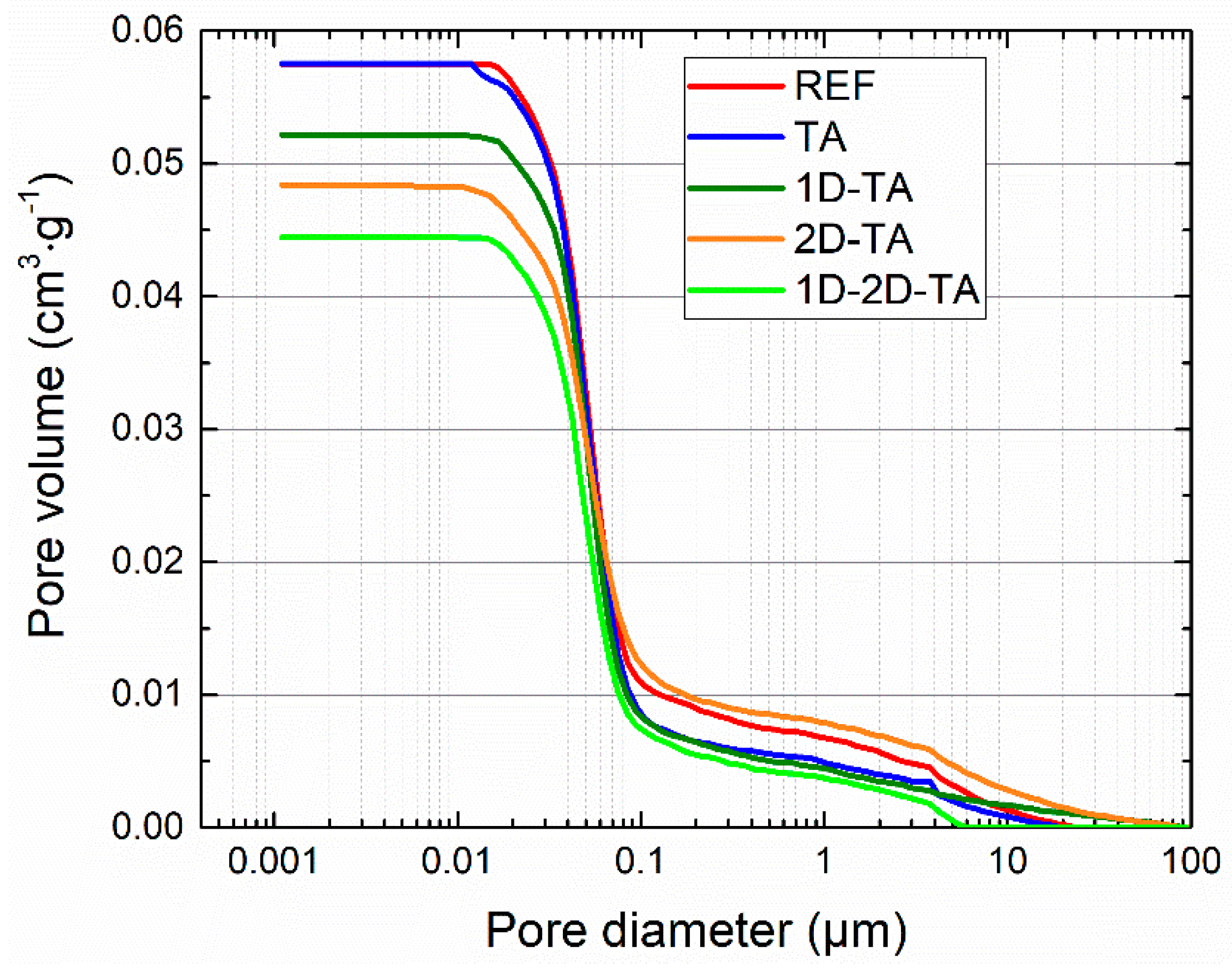
Figure 8.
Mechanical parameters of prepared samples: a) flexural strength, b) Dynamic Young’s modulus and c) comparison of compressive strengths before and after 24 h water immersion.
Figure 8.
Mechanical parameters of prepared samples: a) flexural strength, b) Dynamic Young’s modulus and c) comparison of compressive strengths before and after 24 h water immersion.
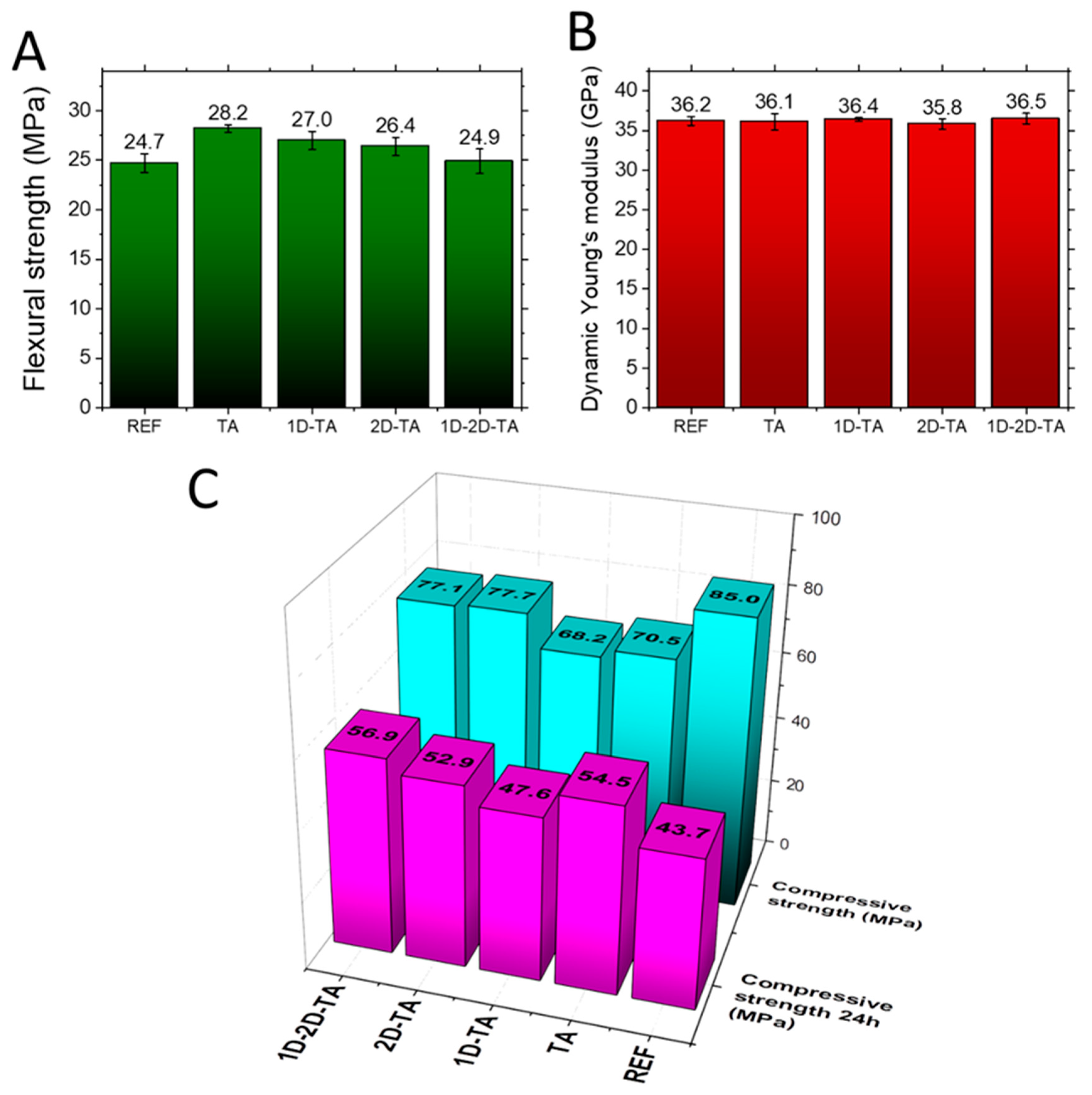
Figure 9.
Water absorption of samples after 24 h immersion.
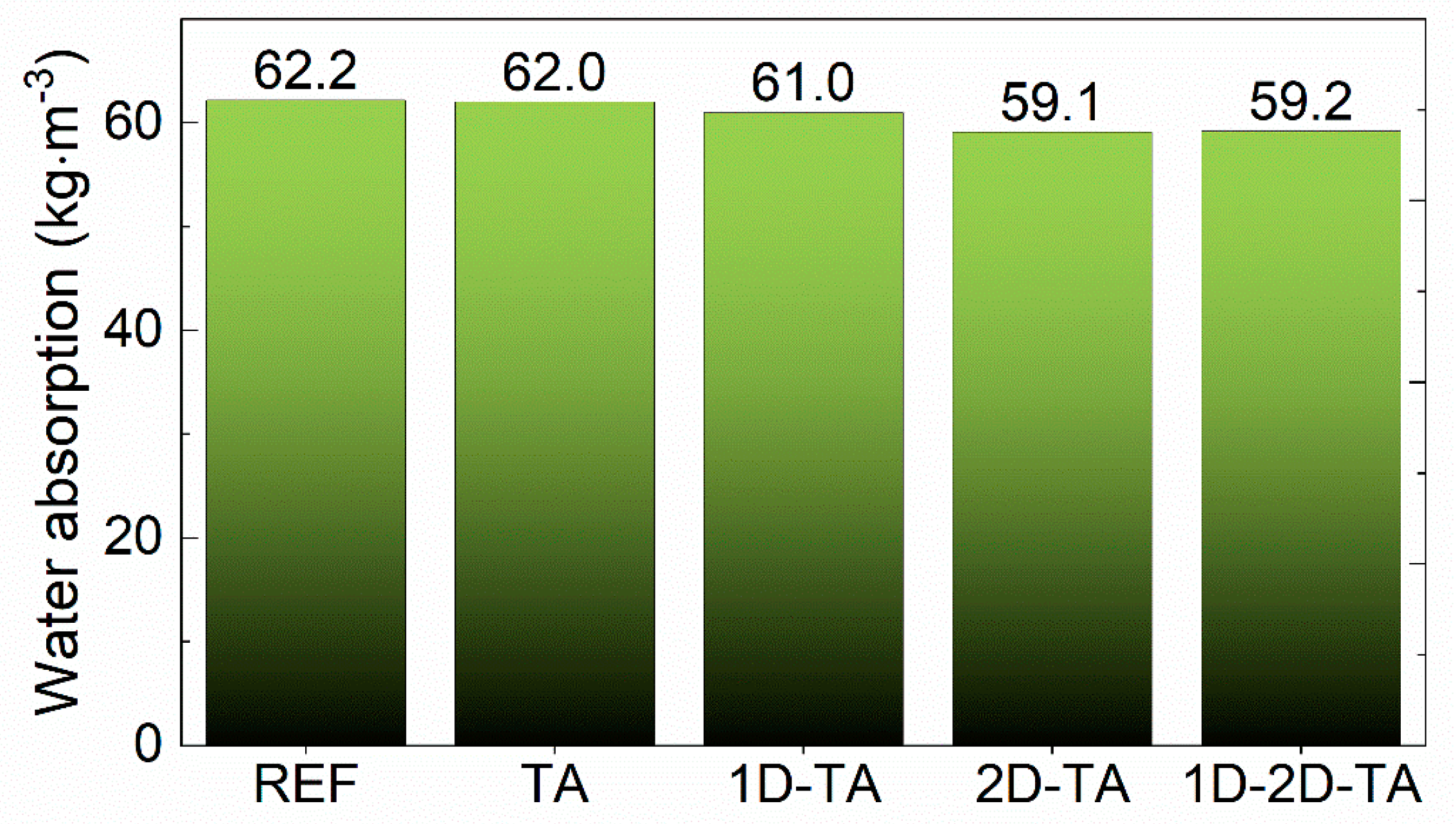
Table 1.
Fresh mixture properties.
| Mixture | Mass (g) | ||||||||
|---|---|---|---|---|---|---|---|---|---|
| MgO | MgCl2∙6H2O | Water | PG1 | PG2 | PG3 | TA | 1D | 2D | |
| PASTE | 450.0 | 453.97 | 281.60 | - | - | - | - | - | - |
| REF | 450.0 | 453.97 | 281.60 | 450.0 | 450.0 | 450.0 | - | - | - |
| TA | 450.0 | 453.97 | 281.60 | 450.0 | 450.0 | 450.0 | 2.37 | - | - |
| 1D-TA | 450.0 | 453.97 | 281.60 | 450.0 | 450.0 | 450.0 | 2.37 | 5.92 | - |
| 2D-TA | 450.0 | 453.97 | 281.60 | 450.0 | 450.0 | 450.0 | 2.37 | - | 5.92 |
| 1D-2D-TA | 450.0 | 453.97 | 281.60 | 450.0 | 450.0 | 450.0 | 2.37 | 2.96 | 2.96 |
Table 2.
Chemical composition of prepared MOC-based composites obtained from EDS.
| Mixture | wt. % | ||||
|---|---|---|---|---|---|
| O | Mg | Si | Cl | C | |
| REF | 41.5 | 21.6 | 13.1 | 12.4 | 11.4 |
| TA | 39.4 | 24.3 | 13.8 | 11.2 | 11.2 |
| 1D-TA | 42.6 | 18.6 | 17.5 | 11.1 | 10.2 |
| 2D-TA | 38.5 | 26.3 | 16.1 | 12.3 | 6.8 |
| 1D-2D-TA | 39.8 | 26.1 | 14.3 | 13.2 | 6.6 |
Table 3.
Structural parameters.
| Mixture | Bulk density |
Specific density |
Porosity (MIP) |
Total pore volume | Average pore diameter |
|---|---|---|---|---|---|
| (kg·m-3) | (kg·m-3) | (%) | (cm-3·g-1) | (μm) | |
| REF | 2029 ± 28 | 2251 ± 27 | 10.6 ± 0.2 | 0.052 | 0.047 |
| TA | 2030 ± 28 | 2260 ± 27 | 10.5 ± 0.2 | 0.058 | 0.043 |
| 1D-TA | 2035 ± 28 | 2269 ± 27 | 8.8 ± 0.2 | 0.045 | 0.046 |
| 2D-TA | 2031 ± 28 | 2279 ± 27 | 10.5 ± 0.2 | 0.058 | 0.049 |
| 1D-2D-TA | 2035 ± 29 | 2266 ± 27 | 9.2 ± 0.2 | 0.048 | 0.049 |
Disclaimer/Publisher’s Note: The statements, opinions and data contained in all publications are solely those of the individual author(s) and contributor(s) and not of MDPI and/or the editor(s). MDPI and/or the editor(s) disclaim responsibility for any injury to people or property resulting from any ideas, methods, instructions or products referred to in the content. |
© 2023 by the authors. Licensee MDPI, Basel, Switzerland. This article is an open access article distributed under the terms and conditions of the Creative Commons Attribution (CC BY) license (http://creativecommons.org/licenses/by/4.0/).
Copyright: This open access article is published under a Creative Commons CC BY 4.0 license, which permit the free download, distribution, and reuse, provided that the author and preprint are cited in any reuse.
MDPI Initiatives
Important Links
© 2024 MDPI (Basel, Switzerland) unless otherwise stated









